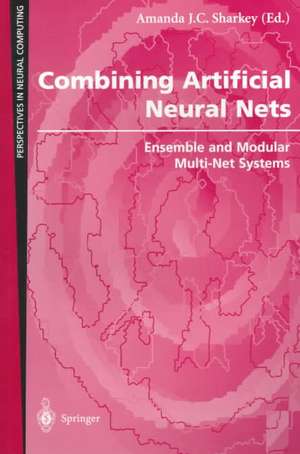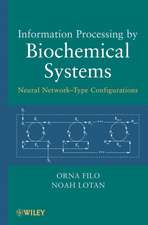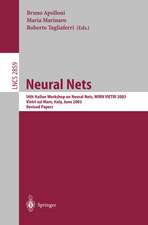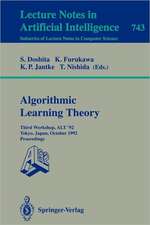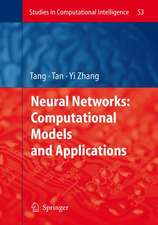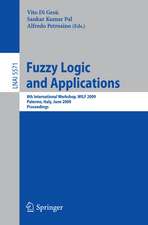Combining Artificial Neural Nets: Ensemble and Modular Multi-Net Systems: Perspectives in Neural Computing
Editat de Amanda J.C. Sharkeyen Limba Engleză Paperback – 22 ian 1999
Din seria Perspectives in Neural Computing
- 20%
 Preț: 986.66 lei
Preț: 986.66 lei - 20%
 Preț: 651.23 lei
Preț: 651.23 lei - 20%
 Preț: 1159.10 lei
Preț: 1159.10 lei - 20%
 Preț: 987.65 lei
Preț: 987.65 lei - 20%
 Preț: 648.44 lei
Preț: 648.44 lei - 20%
 Preț: 583.14 lei
Preț: 583.14 lei - 20%
 Preț: 989.79 lei
Preț: 989.79 lei - 20%
 Preț: 327.29 lei
Preț: 327.29 lei - 20%
 Preț: 339.34 lei
Preț: 339.34 lei - 20%
 Preț: 639.52 lei
Preț: 639.52 lei - 20%
 Preț: 648.59 lei
Preț: 648.59 lei - 20%
 Preț: 335.52 lei
Preț: 335.52 lei - 20%
 Preț: 646.80 lei
Preț: 646.80 lei - 20%
 Preț: 641.49 lei
Preț: 641.49 lei - 15%
 Preț: 643.99 lei
Preț: 643.99 lei - 20%
 Preț: 329.91 lei
Preț: 329.91 lei - 20%
 Preț: 326.46 lei
Preț: 326.46 lei - 20%
 Preț: 643.50 lei
Preț: 643.50 lei - 20%
 Preț: 398.07 lei
Preț: 398.07 lei - 20%
 Preț: 646.47 lei
Preț: 646.47 lei - 18%
 Preț: 786.36 lei
Preț: 786.36 lei - 20%
 Preț: 326.64 lei
Preț: 326.64 lei - 20%
 Preț: 650.73 lei
Preț: 650.73 lei - 20%
 Preț: 648.26 lei
Preț: 648.26 lei - 20%
 Preț: 652.73 lei
Preț: 652.73 lei - 20%
 Preț: 648.76 lei
Preț: 648.76 lei - 20%
 Preț: 335.18 lei
Preț: 335.18 lei - 20%
 Preț: 334.20 lei
Preț: 334.20 lei - 20%
 Preț: 335.88 lei
Preț: 335.88 lei
Preț: 647.79 lei
Preț vechi: 809.73 lei
-20% Nou
Puncte Express: 972
Preț estimativ în valută:
123.97€ • 134.61$ • 104.13£
123.97€ • 134.61$ • 104.13£
Carte tipărită la comandă
Livrare economică 22 aprilie-06 mai
Preluare comenzi: 021 569.72.76
Specificații
ISBN-13: 9781852330040
ISBN-10: 185233004X
Pagini: 316
Ilustrații: XV, 298 p. 6 illus.
Dimensiuni: 155 x 235 x 17 mm
Greutate: 0.48 kg
Ediția:1st Edition.
Editura: SPRINGER LONDON
Colecția Springer
Seria Perspectives in Neural Computing
Locul publicării:London, United Kingdom
ISBN-10: 185233004X
Pagini: 316
Ilustrații: XV, 298 p. 6 illus.
Dimensiuni: 155 x 235 x 17 mm
Greutate: 0.48 kg
Ediția:1st Edition.
Editura: SPRINGER LONDON
Colecția Springer
Seria Perspectives in Neural Computing
Locul publicării:London, United Kingdom
Public țintă
Professional/practitionerCuprins
1. Multi-Net Systems.- 1.0.1 Different Forms of Multi-Net System.- 1.1 Ensembles.- 1.2 Modular Approaches.- 1.3 The Chapters in this Book.- 1.4 References.- 2. Combining Predictors.- 2.1 Combine and Conquer.- 2.2 Regression.- 2.3 Classification.- 2.4 Remarks.- 2.5 Adaboost and Arcing.- 2.6 Recent Research.- 2.7 Coda.- 2.8 References.- 3. Boosting Using Neural Networks.- 3.1 Introduction.- 3.2 Bagging.- 3.3 Boosting.- 3.4 Other Ensemble Techniques.- 3.5 Neural Networks.- 3.6 Trees.- 3.7 Trees vs. Neural Nets.- 3.8 Experiments.- 3.9 Conclusions.- 3.10 References.- 4. A Genetic Algorithm Approach for Creating Neural Network Ensembles.- 4.1 Introduction.- 4.2 Neural Network Ensembles.- 4.3 The ADDEMUP Algorithm.- 4.4 Experimental Study.- 4.5 Discussion and Future Work.- 4.6 Additional Related Work.- 4.7 Conclusions.- 4.8 References.- 5. Treating Harmful Collinearity in Neural Network Ensembles.- 5.1 Introduction.- 5.2 Overview of Optimal Linear Combinations (OLC) of Neural Networks.- 5.3 Effects of Collinearity on Combining Neural Networks.- 5.4 Improving the Generalisation of NN Ensembles by Treating Harmful Collinearity.- 5.5 Experimental Results.- 5.6 Concluding Remarks.- 5.7 References.- 6. Linear and Order Statistics Combiners for Pattern Classification.- 6.1 Introduction.- 6.2 Class Boundary Analysis and Error Regions.- 6.3 Linear Combining.- 6.4 Order Statistics.- 6.5 Correlated Classifier Combining.- 6.6 Experimental Combining Results.- 6.7 Discussion.- 6.8 References.- 7. Variance Reduction via Noise and Bias Constraints.- 7.1 Introduction.- 7.2 Theoretical Considerations.- 7.3 The BootstrapEnsemble with Noise Algorithm.- 7.4 Results on the Two—Spirals Problem.- 7.5 Discussion.- 7.6 References.- 8. A Comparison of Visual Cue Combination Models.- 8.1Introduction.- 8.2 Stimulus.- 8.3 Tasks.- 8.4 Models of Cue Combination.- 8.5 Simulation Results.- 8.6 Summary.- 8.7 References.- 9. Model Selection of Combined Neural Nets for Speech Recognition.- 9.1 Introduction.- 9.2 The Acoustic Mapping.- 9.3 Network Architectures.- 9.4 Experimental Environment.- 9.5 Bootstrap Estimates and Model Selection.- 9.6 Normalisation Results.- 9.7 Continuous Digit Recognition Over the Telephone Network.- 9.8 Conclusions.- 9.9 References.- 10. Self-Organised Modular Neural Networks for Encoding Data.- 10.1 Introduction.- 10.2 Basic Theoretical Framework.- 10.3 Circular Manifold.- 10.4 Toroidal Manifold: Factorial Encoding.- 10.5 Asymptotic Results.- 10.6 Approximate the Posterior Probability.- 10.7 Joint Versus Factorial Encoding.- 10.8 Conclusions.- 10.9 References.- 11. Mixtures of X.- 11.1 Introduction.- 11.2 Mixtures of X.- 11.3 Summary.- 11.4 References.
Caracteristici
There are no other books covering both modular and ensemble approaches (The ensemble approach uses a variety of methods to create a set of different nets trained on the same task; the modular approach decomposes a task into simpler problems) The presentation of techniques is accompanied by analysis and evaluation of their relative effectiveness on a variety of problems The book focuses on the combination of neural nets, but many of the methods are applicable to a wider variety of statistical methods
